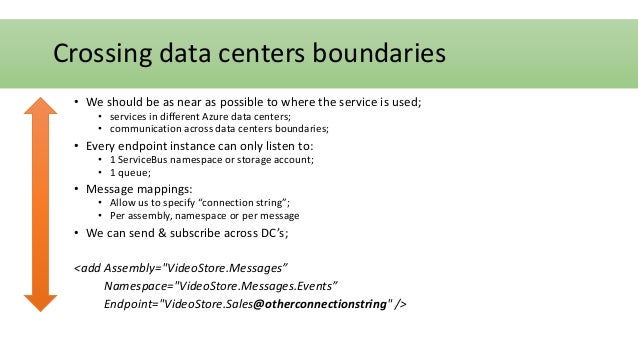
Other microservices subscribe to those events.

NServiceBus provides several options to scale out a system.As described earlier, when you use event-based communication, a microservice publishes an event when something notable happens, such as when it updates a business entity.
#Nservicebus vs masstransit code
NServiceBus helps write code that is robust in production environments, preventing data loss under failure conditions. An exception causes all work to be undone, including the sending of any messages, so that remote services and clients do not get exposed to inconsistent data. Transactions are automatically handled on a per-message basis by default they span all communications and state-management work done by an endpoint. NServiceBus is designed to handle long-running business processes in a robust and scalable way using sagas. Unless developers are careful about how they connect workflow activities, transaction scopes, and communications activities, the process state can get corrupted and exposed to remote services and clients. Keeping it within a service boundary avoids typical performance and maintainability problems. Note that when BizTalk is used within a service it is just an implementation detail that doesn't impact any other services. When designing systems, keep in mind that mixing logical orchestration and routing with business logic, data access, and web services calls results in having slow, complex and unmaintainable code.

BizTalk would be responsible for the integration with existing systems and legacy applications within the relevant services, without crossing the service boundary. NServiceBus would handle the communication between the high-level business services. In these cases, NServiceBus can be used in combination with BizTalk. This is a classical Enterprise Application Integration (EAI) situation and is not what service buses are meant to address. Its primary use case is integration with existing systems and legacy applications, possibly running on different technologies and using proprietary protocols. NServiceBus and BizTalkīizTalk is a centralized message broker with many adapters for third-party applications. Just as it is possible to write a host process and activate WCF explicitly within it, the same can be done with NServiceBus. In terms of architectural style, NServiceBus is more similar to WCF than BizTalk. It's similar to a peer-to-peer mesh that runs alongside code. The bus is part of the infrastructure that is run in-process with a given application's code. There's no physical bus one can point to in the network topology. Despite the common understanding, that's actually a description of the broker architectural style.Ī bus in the context of the bus architectural style, isn't a physical entity.

Bus versus broker architectural stylesĪ "service bus" is often illustrated as a central box, through which all communication goes. This article discusses the similarities and differences between NServiceBus and its Microsoft counterparts. Successful systems use a mix of approaches and technologies for communication, not just NServiceBus.

It is not a replacement for RPC technologies such as WCF or broker integration tools like BizTalk. NServiceBus is designed for communication between business-oriented services in SOA and DDD projects.


 0 kommentar(er)
0 kommentar(er)
